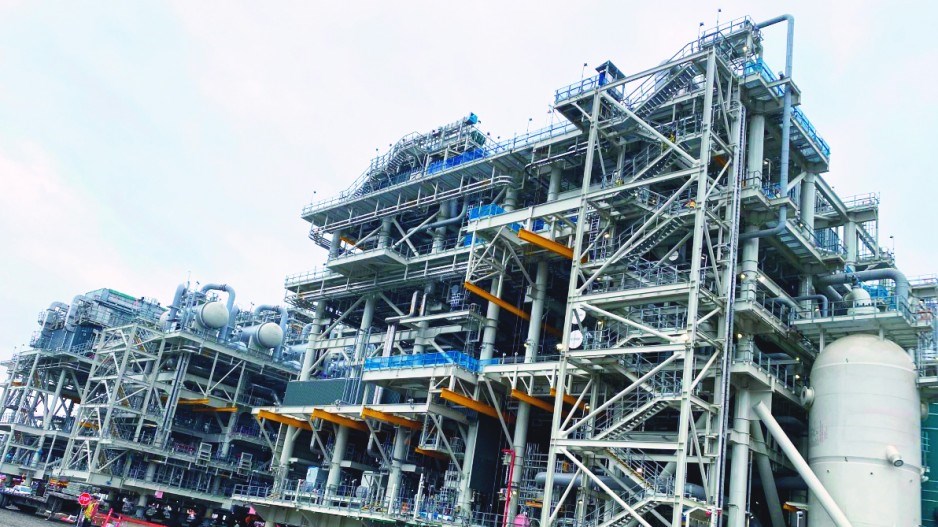While industry players were in Vancouver this week at the Canada Gas and LNG conference to talk about the opportunities and challenges of B.C.’s nascent LNG industry, the Pembina Institute was dashing cold water on the notion that B.C. can develop an LNG industry while meeting its own greenhouse gas (GHG) emissions reductions targets.
The problem is the amount of electricity that would be needed to reduce the emissions intensity of all LNG projects to the point that they would fit within B.C.’s new emissions limits for oil and gas.
Basically, B.C. would need to make huge investments in one form of energy – clean electricity – to permit the growth of another form of energy – liquefied natural gas, the Pembina Institute study warns.
“Devoting large amounts of clean electricity to LNG could drive away investment in growing clean industries such as critical minerals mining and green hydrogen production,” the report, Squaring the Circle, warns. “It could also impact available capacity for the electrification for other parts of B.C.’s economy such as transportation, and buildings.”
If all five LNG projects that are either under construction or in the regulatory queue are built, electrifying the LNG plants as well as the upstream would require the equivalent of eight hydro-electric dams with the generating capacity of Site C dam, the Pembina Institute report estimates.
The report assumes electrification will do all the heavy lifting, however, whereas its possible some of the emissions reductions that industry will be required to accomplish would be accomplished through carbon capture and storage, or carbon offsets.
There is currently one large LNG project being built in B.C. – phase 1 of LNG Canada in Kitimat. A smaller one – Woodfibre LNG – is being built in Squamish.
Phase 1 of LNG Canada is only partially electrified, whereas Woodfibre LNG will be fully electric, as it will use electric drive for its chilling process rather than natural gas, which is what is typically used in an LNG plant.
The LNG Canada plant will use natural gas for its liquefaction process and BC Hydro power for the rest of the Kitimat plant’s operations. It is therefore considered only partially electrified.
Woodfibre LNG and phase 1 of LNG Canada alone will require 1,883 gigawatt hours (GWh) of power just for the liquefaction plants, Pembina estimates -- about 35 per cent of the 5,100 GW/h generating capacity of Site C dam, which is still under construction. Electrifying the upstream sector for the extraction, collection and transportation of the natural gas for those two LNG terminals would require another 10,626 GWh of electricity, Pembina estimates.
So just phase 1 of LNG Canada and Woodfibre LNG alone would require a total of 12,512 GWh – 2.5 times the generating capacity of Site C dam, according to Pembina Institute's calculations.
As for other LNG projects yet to get final investment decisions, they include phase 2 of LNG Canada, the Haisla First Nation’s Cedar LNG project in Kitimat, the Ksi Lisims LNG project in Prince Rupert (which will require a new natural gas pipeline to be built) and an expansion of the FortisBC Tilbury Island LNG plant in Delta.
If all of those LNG plants are built, it would require 6,467 GWh of electricity just for terminal operations, which is more power than Site C dam would generate, according to Pembina’s calculations. When electrification of the upstream is included, it would require up to 40,000 GWh of electricity.
It’s clear that BC Hydro is not planning for that kind of additional power capacity.
“BC Hydro has outlined in its 2021 Integrated Resource Plan that it currently has a surplus of power until 2029,” the Pembina report notes. “In its reference scenario, total electricity demand is projected to grow by 5,875 GWh from 2020 to 2030.
“However… our model suggests that 12,512 GWh will be needed for just LNG Canada Phase 1 and Woodfibre LNG to ensure emissions fit within the 2030 target,” the Pembina report notes.
The Pembina report notes that “even BC Hydro’s most ambitious electrification scenario only estimates an additional 11,741 GWh will be needed by 2030 to electrify the oil and gas sector.”
“This means that even BC Hydro’s most ambitious scenario model does not have sufficient electricity to meet the oil and gas emissions sector target, and this is still only in the case that LNG Canada Phase 1 and Woodfibre LNG are the only projects that become operational.
“Our modelling shows that a large portion of emissions reduction opportunities in the oil and gas sector comes from electrification of terminals and the upstream. As such, for B.C. to meet its 2030 oil and gas emissions reduction target, it will need to build significant new electricity generation to electrify LNG terminals and upstream natural gas production facilities.
"This remains the case even if only LNG Canada Phase 1 and Woodfibre LNG become operational. Thus, the scale of proposed LNG development in B.C. presents a challenge for the province as it seeks to meet its climate targets and build new electricity infrastructure to do so.”
The Pembina Institute does not delve into where new power sources might come from.
Modelling done last year by the Delta E+ Plus Research Group at Simon Fraser University likewise found that the “electrify everything” imperative that B.C. has adopted as a cornerstone of its climate action strategy would require B.C. to at least double its electricity generation in less than three decades.
Given how long it takes and how controversial hydro-electric dams are in B.C., Taco Niet, an engineering professor at SFU’s School of School of Sustainable Energy Engineering, said he doubted B.C. will ever see another large hydro-electric dam built in B.C.
Based on just how much more power B.C. will need, Niet suggested B.C. may have no choice but to consider nuclear power.




